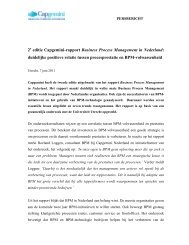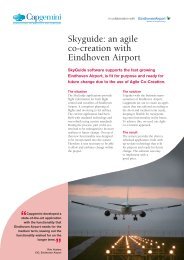IT transformations - Capgemini Consulting Nederland
IT transformations - Capgemini Consulting Nederland
IT transformations - Capgemini Consulting Nederland
Create successful ePaper yourself
Turn your PDF publications into a flip-book with our unique Google optimized e-Paper software.
Long Term Evolution LTE Opportunities and Challenges for Telcos<br />
By Linda Asplund and Priyank Nandan<br />
Abstract: The mobile networks of most operators are witnessing an unprecedented rise in data traffic, due to an increasing<br />
consumer demand to access bandwidth intensive content on-the-go and the proliferation of a large number of mobile devices such as<br />
smartphones and tablets. This trend is exerting extremely high pressure on the capacity constrained network of operators. Faced with<br />
this challenge, wireless providers need to upgrade their network infrastructure in order to keep up with data traffic volumes and deliver<br />
bits more cost-effectively. When compared to some other upgrade options such as HSPA 1 , HSPA+, and WiMAX 2 , Long Term Evolution<br />
(LTE)provides operators with a technically superior and cost effective solution to deliver true mobile broadband experience. Although<br />
LTE standards and the ecosystem have not yet evolved fully and an upgrade requires significant capital investment, operators can still<br />
reap tremendous benefit by formulating the right migration strategy. A focus on key priorities such as pricing, rollout strategy, network<br />
sharing, and spectrum policy will be instrumental in the successful rollout of LTE. Having realized its potential, several operators across<br />
the globe have already deployed LTE commercially and many more are in the fray.<br />
Figure 1: Global Mobile Data Traffic, Exabytes * per Month, 2009-2014<br />
0.09<br />
0.2<br />
0.6<br />
CAGR<br />
108%<br />
2009 2010 2011 2012 2013 2014<br />
* One Exabyte is equal to 1 billion Gigabytes<br />
Source: Cisco Visual Networking Index: Global Mobile Data Forecast Update, 2009-2014<br />
“<br />
The explosion of mobile<br />
data traffic is exerting<br />
unprecedented demand on<br />
networks<br />
”<br />
1.2<br />
2.2<br />
3.6<br />
The Need for LTE<br />
The increasing proliferation of a range<br />
of Internet enabled mobile devices,<br />
such as tablets, smart-phones, and<br />
e-readers has added to the rising<br />
consumer need to access rich content<br />
on the go. This phenomenon has<br />
resulted in the explosion of mobile<br />
data traffic (see Figure 1) exerting<br />
an unprecedented demand on the<br />
network of wireless operators. Driving<br />
this boom will be the increasing<br />
consumption of mobile video,<br />
which will consume nearly 66%<br />
of all mobile data traffic by 2014 3 .<br />
Bandwidth intensive applications,<br />
especially those based on video,<br />
expose the capacity bottlenecks<br />
and the gap which customers are<br />
increasingly facing between peak<br />
rates in perfect conditions and real<br />
everyday experiences. It is, therefore,<br />
imperative for operators to ensure that<br />
the average user’s mobile experience<br />
is not compromised especially in high<br />
traffic areas.<br />
1 High Speed Packet Access is the amalgamation of<br />
two mobile telephony protocols, High Speed Downlink<br />
Packet Access (HSDPA) and High Speed Uplink Packet<br />
Access (HSUPA).<br />
2 Worldwide Interoperability for Microwave Access.<br />
3 Cisco Visual Networking Index, Global Mobile Data<br />
Traffic Forecast Update, 2009-2014.<br />
44
















